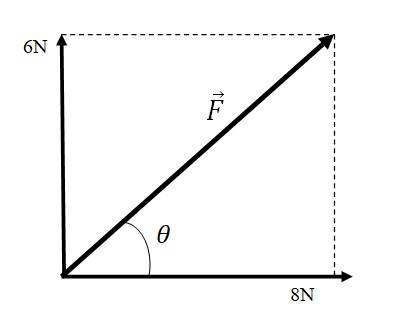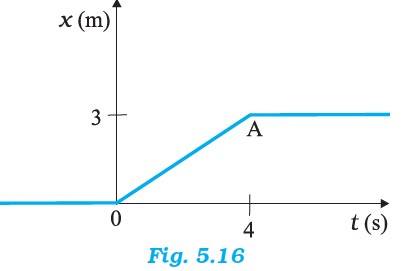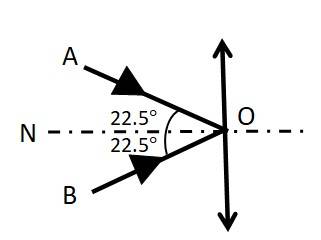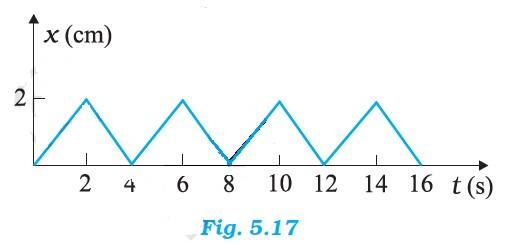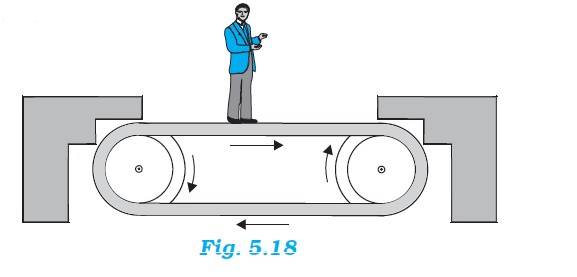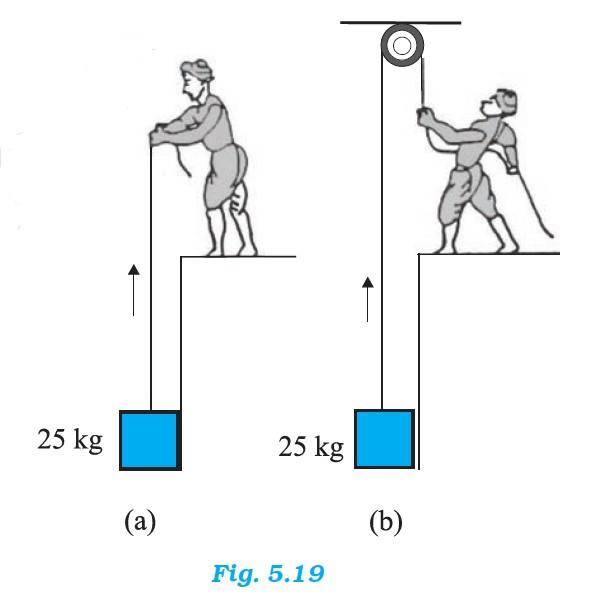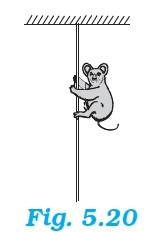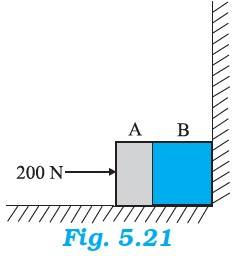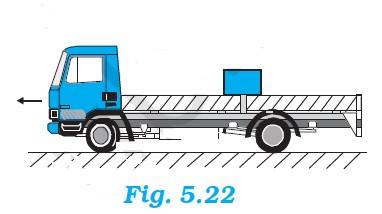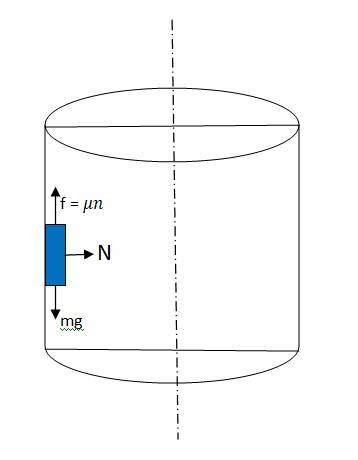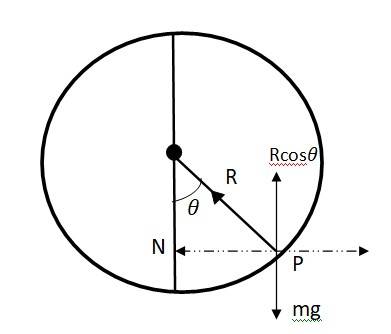
NCERT Solutions for Class 11 Physics Chapter 4 Laws of Motion are an excellent resource for students who want to study on their own. The students can find the Laws of Motion Class 11 NCERT solutions to all the exercise questions in the chapter “Laws of Motion” on this page. These Laws of Motion Class 11 Solutions provide a structured and organised way of learning, which helps students stay focused and motivated. The NCERT Solutions for Class 11 Physics have been meticulously crafted to provide precise and credible information aligned with the updated CBSE Syllabus, ensuring a comprehensive understanding of the fundamental concepts covered in this chapter.
This NCERT Chapter 4 Laws of Motion explains in detail Newton’s Laws of Motion. Newton proposed 3 laws of motion. The laws explain concepts like force, acceleration, momentum, velocity etc.
- Laws of Motion: Topics Overview
- NCERT Solution for Class XI Physics Chapter Laws of Motion PDF Download
- Laws of Motion Solutions and FAQs
Laws of Motion: Topics Overview
- Introduction to Laws of Motion
- Aristotle’s fallacy
- The law of inertia
- Newton’s first law of motion
- Newton’s second law of motion
- Newton’s third law of motion
- Conservation of momentum
- Equilibrium of a particle
- Common forces in mechanics
- Circular motion
- Solving problems in mechanics
NCERT Solution for Class XI Physics Chapter Laws of Motion PDF Download
Laws of Motion Class 11 NCERT Solutions PDF is available for download here. Laws of motion is an important chapter that explains Newton’s laws of motion. The students can download the PDF with the solutions to all the exercise questions asked from Class 11 Chapter Laws of Motion in the NCERT textbook. The NCERT Class 11 Physics Chapter 4 Exercise Solutions PDF download can be downloaded for free from here.
Download Here: NCERT Solution for Class XI Physics Chapter Laws of Motion PDF
Explore exams which ask questions on physics ncert solutions class 11th
Select your preferred stream
Laws of Motion Solutions and FAQs
Q5.1 Give the magnitude and direction of the net force acting on
(a) a drop of rain falling down with a constant speed,
(b) a cork of mass 10 g floating on water,
(c) a kite skillfully held stationary in the sky,
(d) a car moving with a constant velocity of 30 km/h on a rough road,
(e) a high-speed electron in space far from all material objects, and free of
electric and magnetic fields.
Ans.5.1 Since the raindrop is falling at a constant speed, the acceleration is zero. When the acceleration is 0, the force acting on the drop will also become zero ( since F = ma)
- Since the cork is floating on water, the weight of the cork is balanced by upward force of water. So the net force on the cork is 0.
- Since the kite is held stationary in the sky, the net force is 0
- Since the car is moving at a constant velocity, the acceleration is 0, hence the net force is also 0.
- The net force acting on the high speed electron will be zero since the electron is far from the material objects and free of electric and magnetic field.
Q.5.2 A pebble of mass 0.05 kg is thrown vertically upwards. Give the direction and magnitude of the net force on the pebble,
(a) during its upward motion,
(b) during its downward motion,
(c) at the highest point where it is momentarily at rest. Do your answers change if the pebble was thrown at an angle of 45° with the horizontal direction?
(Ignore air resistance.)
Ans.5.2 During the upward motion f the pebble, the acceleration due to gravity acts downwards. The magnitude of the force is
F = ma = 0.05 kg 10 m/s2 = 0.5 N and the direction of force is downwards.
During its downward motion – the force is 0.5 N and the direction is downwards.
When the pebble is thrown at an angle of 45 with the horizontal direction, it will have both horizontal component of force and vertical component of force during its upward journey, When it reaches the maximum height, the vertical component of velocity will becomes zero and the force acting will be 0.5 N and acting downwards.
Q5.3 Give the magnitude and direction of the net force acting on a stone of mass 0.1 kg,
(a) just after it is dropped from the window of a stationary train,
(b) just after it is dropped from the window of a train running at a constant velocity of 36 km/h,
(c) just after it is dropped from the window of a train accelerating with 1 m s-2,
(d) lying on the floor of a train which is accelerating with 1 m s-2, the stone being at rest relative to the train. (Neglect air resistance throughout.)
Ans.5.3 Mass of the stone, m = 0.1 kg, Acceleration due to gravity = 10 m/s2
Net force = 0.1 10 N = 1.0 N. The direction of force is downwards.
Since the train is moving at a constant velocity, the acceleration imparted by the train is zero. Only acceleration acting on the stone is gravity. So the force will be 1.0 N, acting downwards.
The acceleration of the train = 1 m/s2, so the force exerted by the train = 0.1 1 N = 0.1 N and it is acting in the horizontal direction. But when the stone is dropped, the force started acting on the stone is only due to gravity, the train moving force has no effect. So the net force is = 0.1 10 N = 1.0 N and it is acting vertically downwards.
When the stone is lying on the train floor, the only force acting on the stone is due to the acceleration of the train. So the net force on the stone = 0.1 1 N. The direction is horizontal along the motion of the train.
Q.5.4 One end of a string of length l is connected to a particle of mass m and the other to a small peg on a smooth horizontal table. If the particle moves in a circle with speed v the net force on the particle (directed towards the centre) is:
(i) T,
(ii) T -
(iii) T +
(iv) 0 T is the tension in the string. [Choose the correct alternative].
Ans.5.4 The net force acting on the string is the tension of the string, no other forces. Hence the answer is T.
Q.5.5 A constant retarding force of 50 N is applied to a body of mass 20 kg moving initially with a speed of 15 m s-1. How long does the body take to stop?
Ans.5.5 The retarding force, F = 50N, the mass m = 20 kg
From the equation F = ma, we get acceleration a = 50 / 20 m/s2 = 2.5 m/s2
The initial speed , u = 15 m/s, the final speed v =0, from the relation v = u-at, we get
t = u/a = 15/2.5 s = 6s
Q5.6 A constant force acting on a body of mass 3.0 kg changes its speed from 2.0 m s-1 to 3.5 m s-1 in 25 s. The direction of the motion of the body remains unchanged. What is the magnitude and direction of the force?
Ans.5.6 Initial speed, u = 2.0 m/s, the final speed v = 3.5 m/s, the time t = 25 s
From the relation v = u + at, we get acceleration a = (v-u)/t = (3.5 – 2.0 )/ 25s = 0.06 m/s2
The force F = ma, F = 3 0.06 N = 0.18 N
Q. 5.7 A body of mass 5 kg is acted upon by two perpendicular forces 8 N and 6 N. Give the magnitude and direction of the acceleration of the body.
The resultant force F of the two forces 6N and 8N is given by,
F = = 10 N
Acceleration is given by F = ma, a = F/m = 10/5 m/s2 = 2 m/s2
= 6/8, = 36.86
Q.5.8 The driver of a three-wheeler moving with a speed of 36 km/h sees a child standing in the middle of the road and brings his vehicle to rest in 4.0 s just in time to save the child. What is the average retarding force on the vehicle? The mass of the three-wheeler is 400 kg and the mass of the driver is 65 kg.
Ans.5.8 The initial speed of 3 wheeler, u = 36 km/h = 10 m/s
The final velocity of the 3 wheeler, v = 0
The time t = 4 s
From the relation, v = u-at, we get, a = u/t = 10/4 m/s2 = 2.5 m/s2
The total mass acting on the 3 wheeler, m = mass of the 3 wheeler + mass of the driver = 400 +65 kg = 465 kg
The average retarding force F is given by F = ma = 465 2.5 N = 1162.5 N = 1.2 N
Q5.9 A rocket with a lift-off mass 20,000 kg is blasted upwards with an initial acceleration of 5.0 m s-2. Calculate the initial thrust (force) of the blast.
Ans.5.9 The mass of the rocket, m = 20000 kg
When the rocket is fired, gravitational acceleration tries to pull it down. Hence the effective acceleration on the rocket = rocket acceleration + gravitational acceleration
The acceleration, a = 5 m/s2 , gravitational acceleration = 10 m/s2
Total acceleration = 5 +10 = 15 m/s2
Thrust force = 20000 15 N = 3 .0 N
Q.5.10 A body of mass 0.40 kg moving initially with a constant speed of 10 m s-1 to the north is subject to a constant force of 8.0 N directed towards the south for 30 s. Take the instant the force is applied to be t = 0, the position of the body at that time to be x = 0, and predict its position at t = –5 s, 25 s, 100 s.
Ans.5.10 Given, the mass of the body = 0.4 kg, Initial speed = 10m/s, Initial force, Retarding force, F = - 8 N
- At t = -5s, Due to constant speed, the acceleration of the body = 0
From the relation, s = ut + (1/2)at2, we get
s = 10 + 0 = -50 m
At t = 25s, The acceleration of the body due to retarding force, from the relation F = ma, a = -8/0.4 m/s2 = - 20 m/s2
From the relation, s = ut + at2, , we get
s = 10 + = -6000m
At t = 100s
For the first 30 s, while the body moves towards North, the opposite force of 8 N acts on it and from the relation s = ut + (1/2)at2, , we get
S30 = 10 30 + = -8700m
The speed after 30 sec, v = u+at
v = 10 –(20 = -590 m/s
The distance covered in next 70 s,
S70 = -590 = -41300m
The position after 100s = S30 + S70 = -8700 -41300 = -50 km
Q5.11 A truck starts from rest and accelerates uniformly at 2.0 m s-2. At t = 10 s, a stone is dropped by a person standing on the top of the truck (6 m high from the ground). What are the (a) velocity, and (b) acceleration of the stone at t = 11s? (Neglect air resistance.)
Ans.5.11 The acceleration of the truck, a = 2 m/s2, t = 10 s, Initial velocity, u = 0, from the equation v = u + at, we get v = 2 = 20 m/s
At time t = 11 s, the horizontal component of the velocity Vx remains unchanged due to no air resistance. Hence Vx = 20 m/s
The vertical component of the velocity Vy is expressed as
Vy = u + t
Here t =11-10 = 1 s, 10 m/s2, u = 0
Vy = 10 m/s
The resultant velocity V is given by V = ( + )1/2 = 22.36 m/s
=Vy/Vx=10/20, 26.57 w.r.t. horizontal
Q.5.12 A bob of mass 0.1 kg hung from the ceiling of a room by a string 2 m long is set into oscillation. The speed of the bob at its mean position is 1 m s-1. What is the trajectory of the bob if the string is cut when the bob is (a) at one of its extreme positions, (b) at its mean position?
Ans.5.12 When the bob is at extreme position, the velocity at that point is zero. If the string is cut at that location, the bob will fall because of its own weight
- At the mean position, if the string is cut, due to horizontal velocity, the bob will act like a projectile and will fall on the ground, following a parabolic path.
Q.5.13 A man of mass 70 kg stands on a weighing scale in a lift which is moving
(a) upwards with a uniform speed of 10 m s-1,
(b) downwards with a uniform acceleration of 5 m s-2,
(c) upwards with a uniform acceleration of 5 m s-2. What would be the readings on the scale in each case?
(d) What would be the reading if the lift mechanism failed and it hurtled down freely under gravity?
Ans.5.13 The mass of the man, m = 70 kg, g = 10 m/s2, Let W be the reading on the weighing scale
- When the lift is moving upward with uniform speed of 10 m/s, the acceleration = 0
The value of W is given by W = mg = 70 = 700 N
The lift is moving downward with acceleration, a = 5m/s2 Using Newton’s 2nd law of motion, the equation of motion can be written as W + ma = mg or W = m(g-a)
= 70 (10-5) = 350 N
The lift is moving upward with acceleration of a =5m/s2 . Using Newton’s 2nd law,
W = m (g+a) = 70 = 1050 N
If the lift mechanism fails, the lift will come down with acceleration due to gravity, a = g
W = m (g –a) = 0. This is the state of weightlessness.
Q.5.14 Figure 5.16 shows the position-time graph of a particle of mass 4 kg. What is the
(a) force on the particle for t < 0, t > 4 s, 0 < t < 4 s?
(b) impulse at t = 0 and t = 4 s? (Consider one-dimensional motion only).
Ans 5.14 For t<0, the distance covered by the particle x is zero. Hence force on the particle is zero. For t>4s, the particle is moving at a constant distance, so the force will be zero. For 0
Impulse is given by the equation, Impulse = total change of momentum. At t = 0, u = 0, v = distance / time = ¾ = 0.75 m/s
Impulse = 4 (0.75-0) kg-m/s = 3 kg-m/s
Q.5.15 Two bodies of masses 10 kg and 20 kg respectively kept on a smooth, horizontal surface are tied to the ends of a light string. A horizontal force F = 600 N is applied to (i) A, (ii) B along the direction of string. What is the tension in the string in each case?
Ans.5.15
m = m1 + m2
If and be the corresponding velocities of two nuclei then total linear momentum after disintegration = m1 + m2
Since at the initial stage, mass nuclei was at rest, so the initial linear momentum = 0
From the law of conservation we know
Total linear momentum before disintegration = total momentum after disintegration
0 = m1 + m2
= - m2 / m1
-ve sign indicates that the two velocities and are in opposite direction
Q.5.18 Two billiard balls each of mass 0.05 kg moving in opposite directions with speed 6 m s-1collide and rebound with the same speed. What is the impulse imparted to each ball due to the other?
Ans.5.18 Mass of each ball, m = 0.05 kg
Initial velocity of each ball, u = 6 m/s= 0.05 6 = 0.3 kg-m/s
After the collision, the ball changes the direction of motion without the change in magnitude of the velocity, so
the final momentum after collision of the first ball = - 0.05 6 = - 0.3 kg-m/s
the final momentum after collision of the second ball = 0.05 6 = 0.3 kg-m/s
Impulse imparted to the first ball =(-0.3) – (0.3) = -0.6 kg-m/s
Impulse imparted to the second ball = (0.3) – (-0.3) = 0.6 kg-m/s
The two impulses are opposite in direction.
Q.5.19 A shell of mass 0.020 kg is fired by a gun of mass 100 kg. If the muzzle speed of the shell is 80 m s-1, what is the recoil speed of the gun?
Ans.5.19 The mass of the shell, m = 0.020 kg
The mass of the gun, M = 100 kg
Speed of the shell, v = 80 m/s
The initial velocity of the shell and the gun = 0, so the initial momentum of the system = 0
Applying the law of conservation of momentum, the initial momentum = final momentum
0 = mv – MV, where V is the recoil speed of the gun
V = mv/M = 0.020 80 / 100 = 0.016 m/s
Q.5.20 A batsman deflects a ball by an angle of 45° without changing its initial speed which is equal to 54 km/h. What is the impulse imparted to the ball? (Mass of the ball is 0.15 kg.)
Ans.5.20
Velocity of the ball , u = 54 km/h = 15 m/s, mass of the ball, m = 0.15 kg
The ball is deflected back such that the included angle is 45
The initial momentum of the ball, along the direction of NO is = mu = 0.15 15 cos 22.5 = 2.0787 kg-m/s
The final momentum of the ball = mu along ON
Impulse = change of momentum = mu - (-mu ) = 2mu = 4.16 kg-m/s
Q.5.21 A stone of mass 0.25 kg tied to the end of a string is whirled round in a circle of radius 1.5 m with a speed of 40 rev./min in a horizontal plane. What is the tension in the string ? What is the maximum speed with which the stone can be whirled around if the string can withstand a maximum tension of 200 N ?
Ans.5.21 Mass of the stone, m = 0.25 kg
Radius of the circular path = 1.5 m
Speed = 40 rev/min = 0.67 rev/s
Angular velocity, = 2 = 2 = 4.19 rev/s
The tension of the string, T = m r = 0.25 = 6.59 N
Maximum tension of the string, = 200 N
From the equation = /r, =
= 200 /0.25
= 34.64 m/s
Q.5.22 If, in Exercise 5.21, the speed of the stone is increased beyond the maximum permissible value, and the string breaks suddenly, which of the following correctly describes the trajectory of the stone after the string breaks :
(a) the stone moves radially outwards,
(b) the stone flies off tangentially from the instant the string breaks,
(c) the stone flies off at an angle with the tangent whose magnitude depends on the speed of the particle ?
Ans.5.22 (c) solution not possible as the stone will fly off tangentially. The answer is (b)
Q.5.23 Explain why
(a) a horse cannot pull a cart and run in empty space,
(b) passengers are thrown forward from their seats when a speeding bus stops suddenly,
(c) it is easier to pull a lawn mower than to push it,
(d) a cricketer moves his hands backwards while holding a catch.
Ans.5.23 A horse can pull a cart by the reaction force generated by the ground to its feet. In an empty space, no reaction force will be generated and it cannot pull a cart.
During the movement of the bus, passenger’s whole body experiences the inertia of motion of the bus. When a bus brakes, the lower part comes to stand still along with the bus but the upper part continues with the same inertia of motion.
While pulling a lawn mower, the vertical component of the applied force acts upwards and it reduces the effective weight of the lawn mower, make it easy to operate. In case of pushing the lawn mower, the vertical component acts downwards, effectively increasing the weight of the lawn mower.
When the batsman hits the ball, the ball will have a large momentum. When the fielder moves his hands backward, the time of impact is increased, thus impact force is reduced.
Q.5.24 Figure 5.17 shows the position-time graph of a body of mass 0.04 kg. Suggest a suitable physical context for this motion. What is the time between two consecutive impulses received by the body ? What is the magnitude of each impulse?
Ans.5.24 This graph could be of a ball rebounding between two walls separated by a distance of 2 cm. The ball rebounds every 2 secs between the walls with uniform velocity.
Velocity of rebounding = displacement / time = ( 2 )/2 = 0.01 m/s
Initial momentum = mu = 0.04 4 kgm/s
Final momentum = -mu = -4 kgm/s
Magnitude of Impulse = Initial momentum – final momentum = 8 kgm/s
The time between two consecutive impulses is 2 secs, so the ball receives an impulse every 2 seconds.
Q.5.25 Figure 5.18 shows a man standing stationary with respect to a horizontal conveyor belt that is accelerating with 1 m s-2. What is the net force on the man? If the coefficient of static friction between the man’s shoes and the belt is 0.2, up to what acceleration of the belt can the man continue to be stationary relative to the belt ?(Mass of the man = 65 kg.)
Ans.5.25 The acceleration of the conveyer belt, a = 1 m/s2
Coefficient of static friction, = 0.2
Mass of the man, m = 65 kg
The net force experienced by the man , ma = 1 N = 65 N
This net force is due to the friction between the belt and the man
At maximum static friction
= = 0.2 m/s2
Q.5.26 A stone of mass m tied to the end of a string revolves in a vertical circle of radius R. The net forces at the lowest and highest points of the circle directed vertically downwards are : [Choose the correct alternative]
Lowest Point Highest Point
(a) mg – T1 mg + T2
(b) mg + T1 mg – T2
(c) mg +T1 – (m ) / R mg – T2+ (m ) / R
(d) mg – T1 – (m ) / R mg + T2 + (m ) / R
T1 and v1 denote the tension and speed at the lowest point. T2 and v2 denote corresponding values at the highest point.
Ans.5.26 The net force at the lowest point is denoted by (mg – T1)and the net force at the highest point is denoted by (mg + T2 ), hence option (a) is correct. The forces mg and T1 are in mutually opposite direction at the lowest point and mg and T2 are in the same direction at the highest point.
Q.5.27 A helicopter of mass 1000 kg rises with a vertical acceleration of 15 m s-2. The crew and the passengers weigh 300 kg. Give the magnitude and direction of the
(a) force on the floor by the crew and passengers,
(b) action of the rotor of the helicopter on the surrounding air,
(c) force on the helicopter due to the surrounding air.
Ans.5.27 Given
Mass of the helicopter m1 = 1000 kg
Mass of the crew and passenger m2 = 300 kg
The vertical acceleration of the helicopter, a = 15 m/s2 and acceleration due to gravity g = 10 m/s2
The total mass of the system ,m = m1 + m2 = 1000 + 300 = 1300 kg
Force on the floor by the crew and passengers :
R – m2g =m2a
R = m2 (g+a) = 300 ( 10 + 15 ) N = 7500 N
action of the rotor of the helicopter on the surrounding air
R’ – mg = ma
R’ = m(g+a) = 1300 = 32500 N
(c) force on the helicopter due to the surrounding air.
It is the reaction of the force applied by the rotor on the air. As action and reaction are equal and opposite (Newton’s 3rd law), the force of reaction, F = 32500 N, acting vertically upwards.
Q.5.28 A stream of water flowing horizontally with a speed of 15 m s-1 gushes out of a tube of cross-sectional area 10-2 m2, and hits a vertical wall nearby. What is the force exerted on the wall by the impact of water, assuming it does not rebound ?
Ans.5.28 Speed of water , v = 15 m/s
Cross-sectional area of the tube, A = 10-2 m2
Density of water = 1000 kg/m3
Mass of the water hitting the wall = = 1000 10-2 = 150 kg/s
Force exerted on the wall because of impact of water = mass velocity = 150 N = 2250 N
Q.5.29 Ten one-rupee coins are put on top of each other on a table. Each coin has a mass m. Give the magnitude and direction of
(a) the force on the 7th coin (counted from the bottom) due to all the coins on its top,
(b) the force on the 7th coin by the eighth coin,
(c) the reaction of the 6th coin on the 7th coin.
Ans.5.29 The force on the 7th coin is due to the 3 coins kept above it.
The weight of the 3 coins = 3m
Force exerted on the 7th coin is (3mg) N and the force is acting vertically downwards
The force on the 7th coin by the 8th coin will be the force exerted by the 3 coins above it = (3mg) N, acting downwards.
The 6th coin will experience the force of 4 coins above it, acting downwards = 4mg
Q.5.30 An aircraft executes a horizontal loop at a speed of 720 km/h with its wings banked at 15°. What is the radius of the loop ?
Ans.5.30 The speed of the aircraft, v = 720 km/h = 200 m/s
The angle of banking = 15
From the relation = /rg we get r = / ( g = 14928 m
Q.5.31 A train runs along an unbanked circular track of radius 30 m at a speed of 54 km/h. The mass of the train is 106 kg.
What provides the centripetal force required for this purpose — The engine or the rails ? What is the angle of banking required to prevent wearing out of the rail ?
Ans.5.31 Given
Radius, r = 30m
Speed, v = 54 km/h = 15 m/s
The mass of the train, m = 106 kg
The required centripetal force is provided by the rails to the wheels of the train
The angle of banking required to prevent wearing out of the rails
= / rg = /(30
= 37
Q.5.32 A block of mass 25 kg is raised by a 50 kg man in two different ways as shown in Fig. 5.19. What is the action on the floor by the man in the two cases ? If the floor yields to a normal force of 700 N, which mode should the man adopt to lift the block without the floor yielding ?
Ans.5.32 Mass of the block = 25 kg
Mass of the man = 50 kg
Acceleration due to gravity = 10 m/s2
Weight of the block = 250 N
Weight of the man = 500 N
In the 1st case, the man lifts the block directly, applying an upward force, same as the block = 250 N
Due to Newton’s 3rd law of motion, the downward reaction of the man on the floor = 500 N + 250 N = 750 N
In the 2nd case, the man applies a downward force of 25 kg wt. According to Newton’s 3rd law, the action on the floor by the man 500N-250N = 250N
The man should adopt the second case.
Q.5.33 A monkey of mass 40 kg climbs on a rope (Fig. 5.20) which can stand a maximum tension of 600 N. In which of the following cases will the rope break: the monkey
(a) climbs up with an acceleration of 6 m s-2
(b) climbs down with an acceleration of 4 m s-2
(c) climbs up with a uniform speed of 5 m s-1
(d) falls down the rope nearly freely under gravity?
(Ignore the mass of the rope).
Ans.5.33 Mass of the monkey = 40 kg
Maximum tension of the rope Tmax = 600 N
When the monkey climbs up with an acceleration of 6m / s2
Tension in the rope, T – mg = ma
T = m(g+a) = 40(10+6)= 640 N
Since T > Tmax, the rope will break
When the monkey climbs down with an acceleration of 4m/s2
Tension in the rope T is given by mg – T = ma
T = m(g-a) = 40(10-4) N = 240 N
Since T < T max, the rope will not break
Climbs up with an uniform speed of 5 m/s
In this case, the acceleration = 0
The tension in the rope is given by
T –mg = ma
T = mg = 40
Since T < Tmax, the rope will not break
When the monkey falls down freely under gravity
The tension in the rope is given by the equation
T + mg = ma, since a = g, T = 0
Since T < Tmax, the rope will not break
Q.5.34 Two bodies A and B of masses 5 kg and 10 kg in contact with each other rest on a table against a rigid wall (Fig. 5.21). The coefficient of friction between the bodies and the table is
0.15. A force of 200 N is applied horizontally to A. What are
(a) the reaction of the partition
(b) the action-reaction forces between A and B ? What happens when the wall is removed?
Does the answer to (b) change, when the bodies are in motion?
Ignore the difference between μs and μk
Q.5.35 A block of mass 15 kg is placed on a long trolley. The coefficient of static friction between the block and the trolley is 0.18. The trolley accelerates from rest with 0.5 m s-2 for 20 s and then moves with uniform velocity.
Discuss the motion of the block as viewed by
(a) a stationary observer on the ground,
(b) an observer moving with the trolley.
Ans.5.35 Mass of the block = 15 kg
Coefficient of static friction between the block and the trolley = 0.18
Acceleration of the trolley = 0.5 m/s2
Force experienced by block, F = ma = 15 0.5 = 7.5 N. This fore acts in the direction of motion of the trolley
Force of friction, Ff = = 0.18 N = 27 N
Force experienced by the block is less than the friction, hence for a stationary observer on the ground, the block will be stationary.
When an observer moves with the trolley, the trolley will appear to be at rest.
Q.5.36 The rear side of a truck is open and a box of 40 kg mass is placed 5 m away from the open end as shown in Fig. 5.22. The coefficient of friction between the box and the surface below it is 0.15. On a straight road, the truck starts from rest and accelerates with 2 m s-2. At what distance from the starting point does the box fall off the truck? (Ignore the size of the box).
Ans.5.36 Force on the box , F = ma = 40 2 N = 80 N
Frictional force, Ff = = 0.15 60 N
Net force = F – Ff = 80 – 60 = 20 N
From the equation F = ma, we get the backward acceleration produced in the box
a = 20/40 = 0.5 m/s2
From the equation s = ut + , to travel s = 5 m by the box to fall off from the truck, we get
5 = 0 + 0.5
5 = 0.25 , t = 4.47 s
The travel of truck during t = 4.47 s is
= 0 + 0.5 = 0.5 = 19.98 m
Q.5.37 A disc revolves with a speed of rev/min, and has a radius of 15 cm. Two coins are placed at 4 cm and 14 cm away from the centre of the record. If the co-efficient of friction between the coins and the record is 0.15, which of the coins will revolve with the record ?
Ans.5.37 Speed of revolution of the disc , n = rev/min = 100/3 rpm = 100/(3
Angular acceleration = 2 = 2 = 3.492 rad/s
The coins revolve with the disc. The centripetal force is provided by the frictional force …..(1)
As v = r , the above equation becomes mr
r
r (0.15 = 12 cm
For coin A, r = 4 cm
The condition (r 12 ) is satisfied for the coin placed at r = 4 cm, so coin A will revolve with the disc.
The condition (r 12 ) is not satisfied for the coin placed at r = 14 cm, so coin B will not revolve with the disc.
Q.5.38 You may have seen in a circus a motorcyclist driving in vertical loops inside a death well’ (a hollow spherical chamber with holes, so the spectators can watch from outside).
Explain clearly why the motorcyclist does not drop down when he is at the uppermost point, with no support from below. What is the minimum speed required at the uppermost position to perform a vertical loop if the radius of the chamber is 25 m ?
Ans.5.38 When the motorcyclist is at the uppermost point of the death well, the normal reaction R on the motorcyclist by the ceiling of the chamber acts downwards. His weight mg also acts downwards. The outward centrifugal force acting on the motorcyclist is balanced by two forces.
R + mg = m , where v is the velocity and m is the combined mass of the motorcycle and motorcyclist
Because of the balance between the forces, the motorcyclist does not fall.
The minimum speed required at the uppermost position to perform a vertical loop is given by R = 0 in the above equation.
So mg = m or v = = = 15.8 m/s
Q.5.39 A 70 kg man stands in contact against the inner wall of a hollow cylindrical drum of radius 3 m rotating about its vertical axis with 200 rev/min. The coefficient of friction between the wall and his clothing is 0.15. What is the minimum rotational speed of the cylinder to enable the man to remain stuck to the wall (without falling) when the floor is suddenly removed ?
Ans.5.39
Mass of the man, m = 70 kg
Radius of the drum, r = 3 m
Coefficient of friction between the wall and his clothing, = 0.15
Number of revs of hollow cylindrical drum = 200 rev/min = 200/60 rev/s = 3.33 rev/s
The centripetal force required is provided by the normal N of the wall on the man
N = m = m R
When the floor revolves, the man sticks to the wall of the drum. Hence, the weight of the man (mg) acting downwards is balanced by the frictional force acting vertically upwards.
The man will not fall, if
mg
mg )
= 10/(3 0.15)
Q.5.40 A thin circular loop of radius R rotates about its vertical diameter with an angular frequency . Show that a small bead on the wire loop remains at its lowermost point for . What is the angle made by the radius vector joining the centre to the bead with the vertical downward direction for = ? Neglect friction.
Ans. 5.40
physics ncert solutions class 11th Exam
Student Forum
Popular Courses After 12th
Exams accepted
CA FoundationExams accepted
ICSI ExamExams accepted
BHU UET | GLAET | GD Goenka TestBachelor of Business Administration & Bachelor of Law
Exams accepted
CLAT | LSAT India | AIBEExams accepted
IPMAT | NMIMS - NPAT | SET
Exams accepted
BHU UET | KUK Entrance Exam | JMI Entrance ExamBachelor of Design in Animation (BDes)
Exams accepted
UCEED | NIFT Entrance Exam | NID Entrance ExamBA LLB (Bachelor of Arts + Bachelor of Laws)
Exams accepted
CLAT | AILET | LSAT IndiaBachelor of Journalism & Mass Communication (BJMC)
Exams accepted
LUACMAT | SRMHCAT | GD Goenka Test

